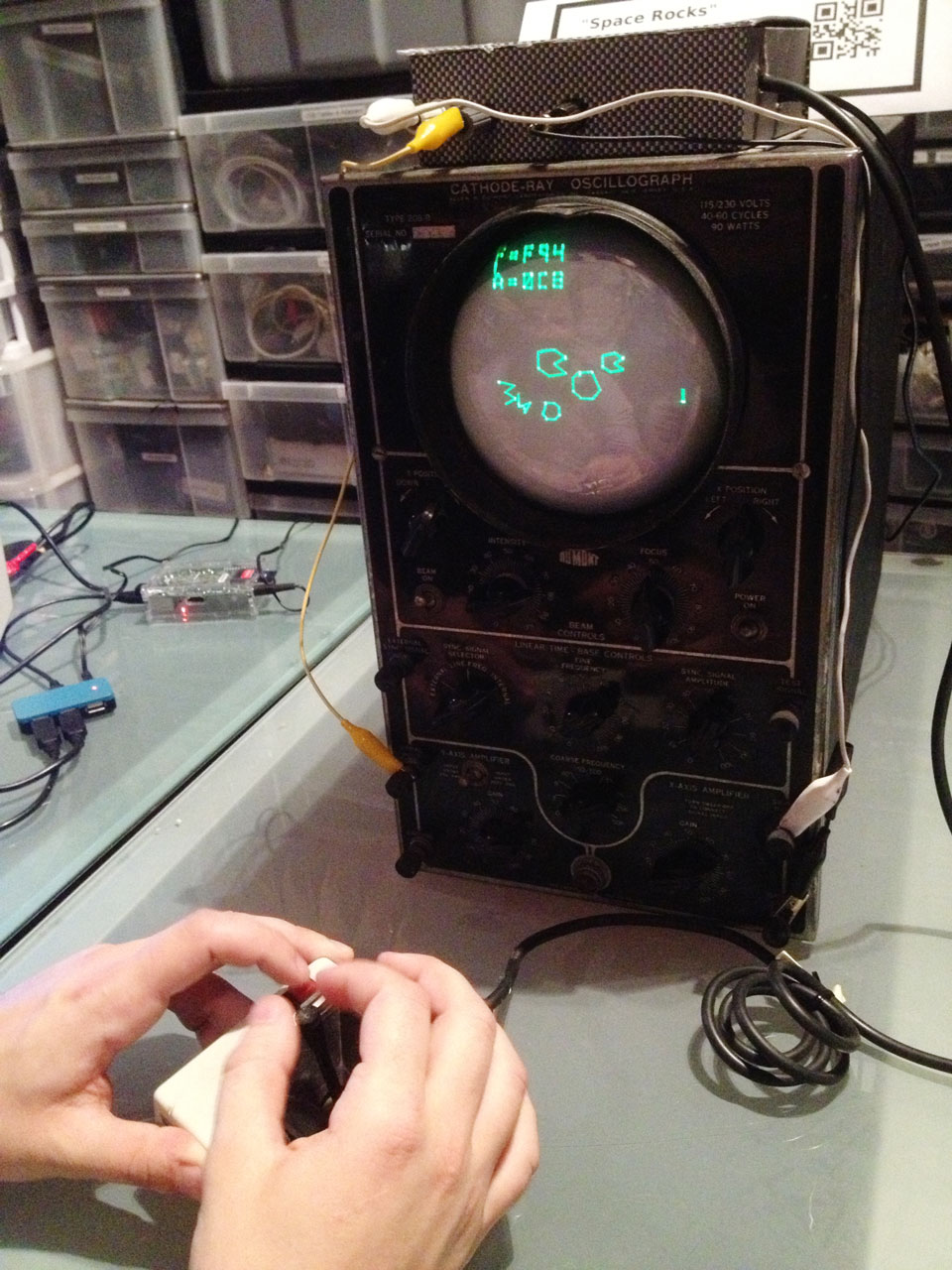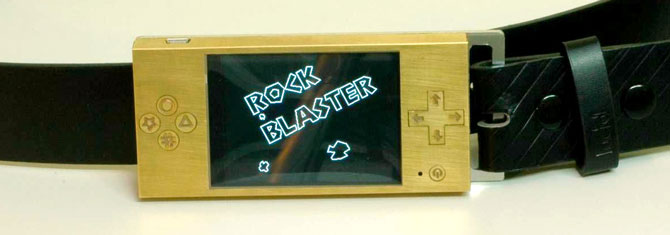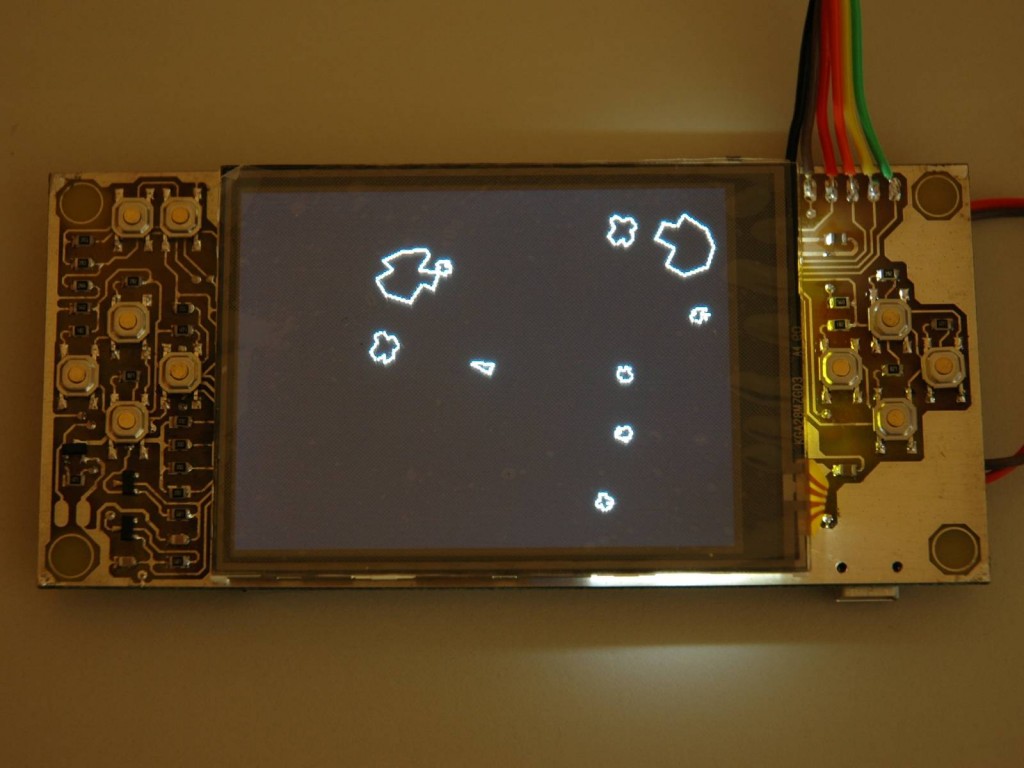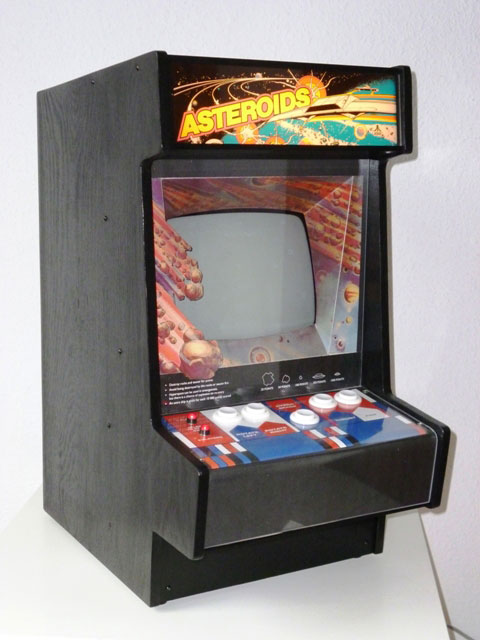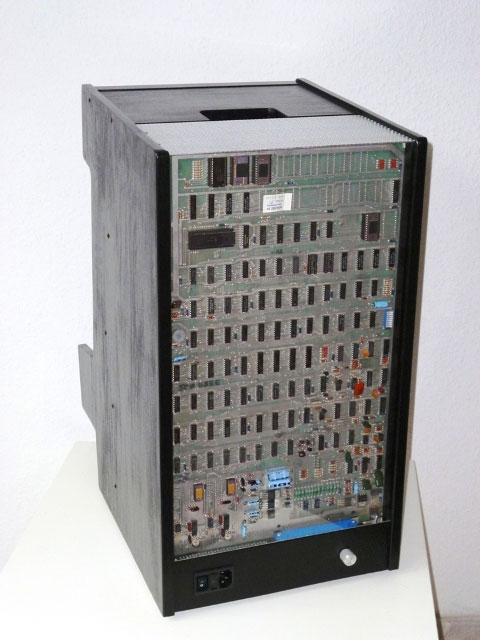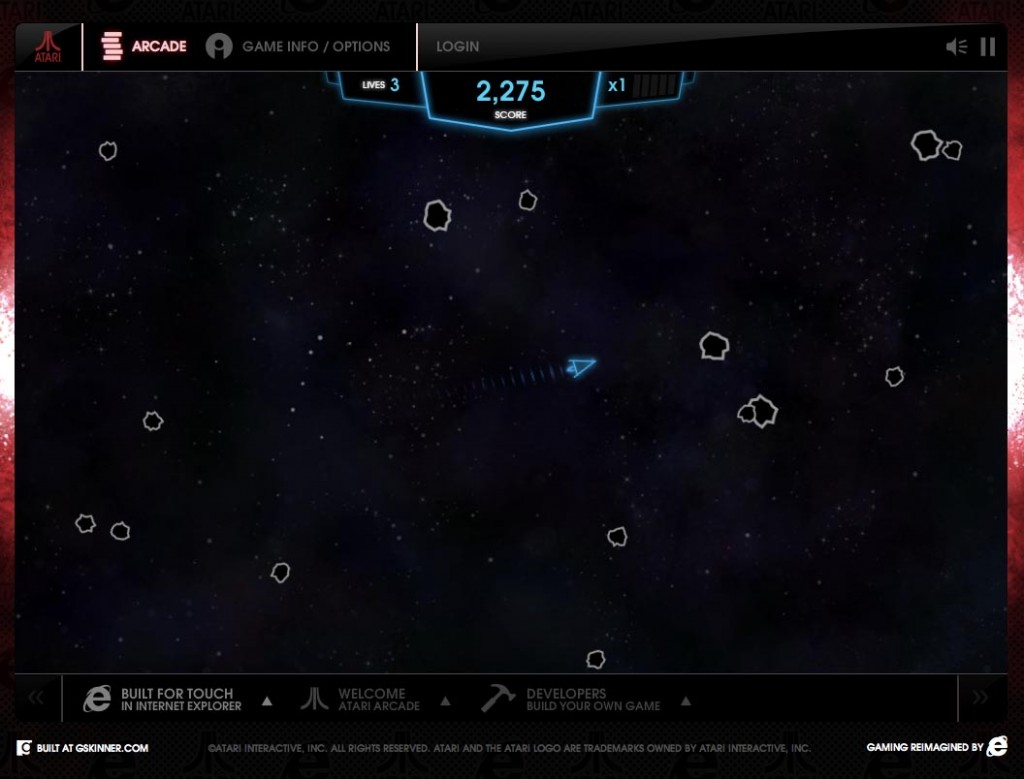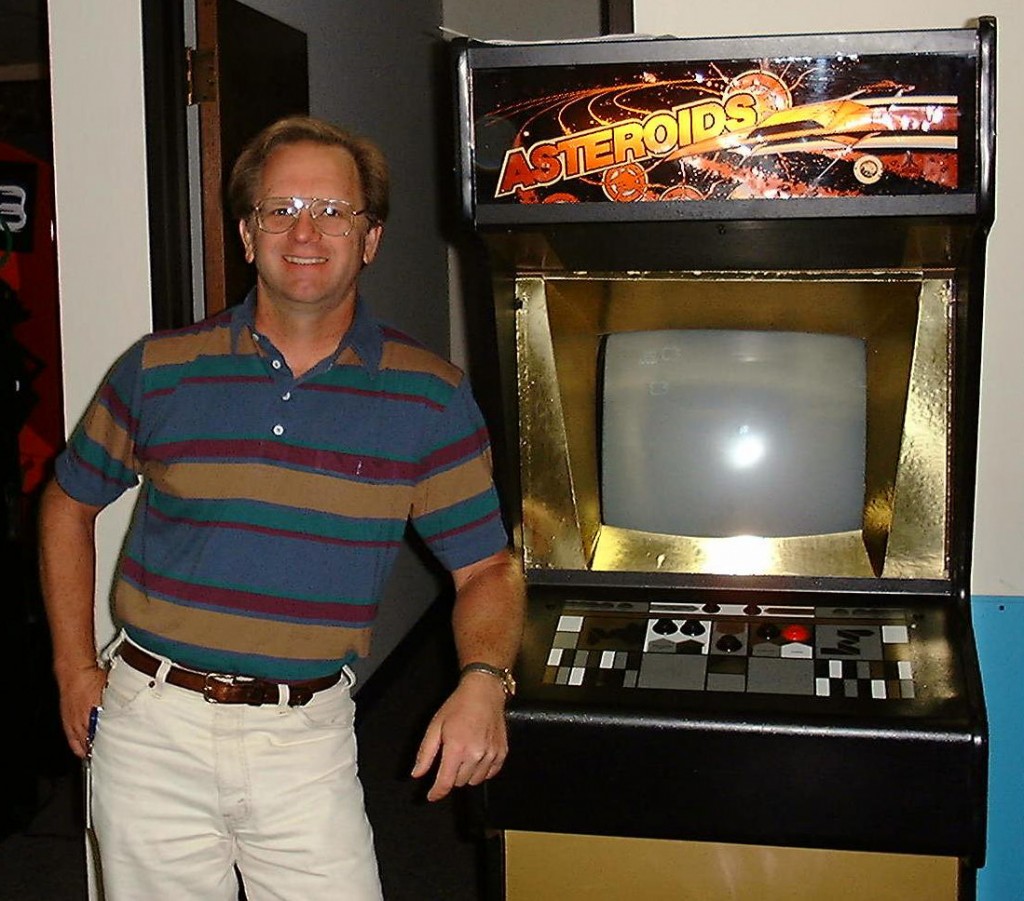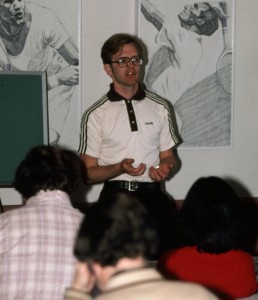Space Rocks on Antique Oscillograph
Posted on September 26, 2013The folks at Brooklyn hackerspace NYC Resistor rescued a 1940s DuMont Labs 208B cathode ray oscillograph from the side of the road, and Trammell Hudson is driving it to do fun things with a microcontroller.
First up, he used this vector-based Asteroids font library to create a authentic 1940s-era Twitter client displayed on the classic scope.
But the pièce de résistance is Space Rocks, a version of you-know-what that runs on this hypnotic vector display. It’s presented as a “serious astronomical simulations and training system…”
While the Delta-V of the simulator space craft was optimistic for its era, the basic acceleration, velocity and position model is reasonably accurate. If the ship passes too closely to one of the space rocks, it is destroyed and the simulation restarts. Once the ship runs out of fuel (measured in hexadecimal in the upper left corner since the CPU can’t perform a DIV/MOD operation fast enough to display decimal numbers), it is stranded and unable to continue its mission.
Space Rocks runs off a Teesny board with code that’s available here. It has made public appearances at the NYC Resistor show in June, and at NYC MakerFaire in August. Check out the writeup on the NYCR blog for video and more.
Asteroids: The Movie
Posted on August 19, 2013Extremely Decent beats Hollywood to the punch.
Human Asteroids
Posted on May 30, 2013Just when we thought there couldn’t be anything cooler in the world of Asteroids, there’s this:
It’s Human Asteroids, a project by Two Bit Circus for their proposed STEAM Carnival, designed to turn kids on to Science, Technology, Engineering, Art, and Math.
Human Asteroids uses a Microsoft Kinect to track the player in a rolling chair, who becomes the spaceship. Asteroids are projected on the ground with lasers, and the player fires with a smartphone.
The player in the video is Nolan Bushnell, founder of Atari.
The STEAM Carnival has a Kickstarter campaign going until midnight on June 2, 2013. If successful (and at the time of writing, they’re close), they plan to take the Carnival on the road at several major west coast American cities.
[UPDATE] This story has been making the rounds today, and Two Bit Circus has just passed its fundraising goal of $100,000, with two days still to go.
Asteroid Belt
Posted on May 16, 2013Makers, behold: the Asteroid Belt.
An Australian known as cunning_fellow has made an LCD belt buckle that plays “Rock Blaster” (wink, wink). The whole project is extremely well-documented on instructables.com.
In the FAQs, he writes:
Q: It costs more to build than a RasPi and only runs at 16Mhz. Why did you bother?
A: If you don’t understand already there is little I can do to help you.
Read all about it at http://www.instructables.com/id/The-Asteroid-Belt/
Thanks to our friends at Adafruit for tipping us off.
See more Asteroids fashion in the archives.
Asteroids Videos
Posted on April 10, 2013People have been posting technical videos about Atari Asteroids on YouTube lately.
Here are (1) an arcade Asteroids Y-vector test point hooked up to an oscilloscope, (2) a short clip of an Asteroids machine with a vector glitch, and (3) a page-turn review of an Atari Asteroids operations manual and schematic.
Asteroids Mini
Posted on March 10, 2013Here’s the goal: having an Asteroids arcade machine at home, with authentic electronics and true vector display, but which isn’t the size of a refrigerator. Jürgen Müller in Hamburg, Germany, has built just that.
His half-scale Asteroids cabinet uses an original Asteroids game PCB and 9″ vector monitor from a broken Vectrex, housed in a custom-built cabinet. He also built a custom XY driver circuit to bring the Vectrex display up to the drawing speed required by Asteroids.
The project is well-documented on Müller’s website: http://www.e-basteln.de/asteroids/asteroids_intro.html
Video Game Showdown: Old School vs. New School
Posted on September 14, 2012The folks at Rocket Jump made this. Spoiler: Asteroids kick ass.
Atari Dives Into HTML5 With Microsoft, Offers SDK
Posted on September 03, 2012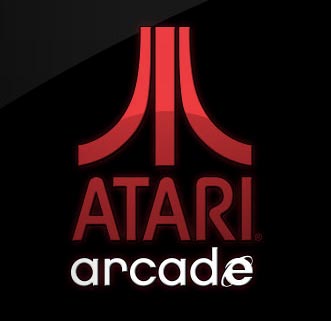 Atari is taking a new direction with its online activities, last week revealing a revamped online arcade and partnership with Microsoft.
Atari is taking a new direction with its online activities, last week revealing a revamped online arcade and partnership with Microsoft.
atari.com/arcade currently offers eight classic titles: Combat, Lunar Lander, Missile Command, Pong, Super Breakout, Yars’ Revenge, Centipede, and of course, Asteroids. The interface is a slick example of what you can do with HTML5 and a multi-touch device, being released as a showcase for Internet Explorer 10 and the Windows 8 Tablet. It works just as well on any other HTM5-capable browser or tablet, but you get ads.
Atari worked with gskinner.com on this project, who re-imagined and re-built the classic titles from scratch, using their CreateJS suite of Javascript libraries and tools. The resulting games vary in design: Pong has a clean arena look, Centipede renders you as a garden gnome defending your turf, and so on.
For Asteroids, they kept close to the original vectorgraphic style: the ship looks the same (although a color), the asteroids are different shapes but the same idea, and the lasers are nice, simple dots. The result is not too bubbly or over-complicated as modern games can be, and yet isn’t trying to make you feel like you’re playing on a lousy old TV. Thumbs-up from us.
The game play is nice and smooth, as is everything on the site. On a computer, you navigate with W-A-S-D or arrow keys, and fire with the spacebar. On a tablet, controls hover over the graphics. The action is basically the same as the arcade, with two differences: you can hold down the fire button to charge up and get more punch out of your laser, and there is no friction. In other versions of Asteroids, you eventually slow down after hitting the thrust button. Here you do not: you have to spin around and reverse-thrust to slow down. This takes a little getting used to, but it’s more like the real experience of shooting asteroids in friction-free space. Clearly based on NASA’s asteroid-shooting training simulators.
The big news with the new Atari Arcade isn’t Asteroids, though — it’s the open invitation to developers. The existing classic games are a showcase, with the idea that anyone can create, distribute, and profit off their own games in the arcade (pending approval). It’s not Facebook (the Asteroids Online app seems to have disappeared). It’s not iTunes (although the latest update of the Atari Classics app is pretty good if you’ve got iOS, and Asteroids Gunner is going strong). Atari Arcade is now creating its own online platform, which can be a go-to game site with the space for user involvement.
Atari has been searching for its identity since becoming active again in the last few years, and this feels like a good fit.
Microsoft has also been developing an increasingly maker-friendly image in recent years, most notably with the whole XBox Kinect story. When the Kinect depth-sensing camera was initially released in November of 2010, open source hardware company Adafruit offered a $1,000 bounty to the first person to create an open source driver. Microsoft said they didn’t condone tampering with their stuff. Adafruit upped the reward to $2,000. Microsoft said, no, really, don’t do that. Adafruit said $3,000, and by that time someone had figured it out. Soon there was an explosion of creative projects in all fields by clever individuals using the Kinect for something other than games. It holds the world record for fastest selling consumer electronics device. Microsoft relaxed its anti-hacker stance (although technically the device wasn’t hacked, in that the USB output is unencrypted, although it all depends on your definition of hacked). And then by June of the next year, Microsoft had come full-circle and released a Software Developer Kit for the Kinect. Microsoft realized that there was a market here, and it earned them major maker cred.
We’ve heard reports of Atari founder Nolan Bushnell-sitings at MakerFaire and various tinker-tech hacker spaces. It seems like a good move to share the fun.
With all this in mind, the Atari Arcade developer page is worth a visit. There is documentation about how they created the games in the arcade, with snippets of code. At GitHub you can download the whole Atari Arcade SDK, including CreateJS and the Atari Arcade Repository.
The classic games are fun to play, but it’s the tip of the iceberg. We look forward to seeing where this goes.
Asteroids’ Ed Logg Honored With 2012 Pioneer Award
Posted on February 07, 2012On Thursday, (Feb 9) the Academy of Interactive Arts & Sciences (AIAS) will present its 2012Â AIAS Pioneer Award to Ed Logg, the man who created Asteroids as we know it.
Some history: In February of 1962, several programmers at MIT created Spacewar!. At the time, it was only available to those few with access to a massive computer, like university students. But nine years later, Nolan Bushnell brought the game’s idea into the arcade with Computer Space, developed at Nutting Associates. He and Ted Dabney took their proceeds from the game and founded Atari, which took off with Pong (1972).
Ed Logg had also played Spacewar! while studying at Stanford’s AI Lab, and followed his interest to Atari’s arcade division by the late 1970’s. His first completed assignment there was Super Breakout in 1978.
He ended up in a brainstorming session with Atari executive Lyle Rains. A follow-up to Computer Space had been shelved long before, due to rights and other issues, but Rains now wanted to resume work on a new spaceship shooting game. This time, instead of shooting another spaceship with an asteroid as incidental debris, the asteroid would be the focus.
Logg suggested using a high-resolution vector display instead of the standard televisions used in other games, which would allow for increased speed and precision. He also introduced greater complexity than Asteroids‘ predecessors. “Computer Space has a pattern,” Logg explains. “You just go through it and you keep running through it.” [1]
Pong had variety in its play, but simplicity in its controls. Computer Space had more complicated controls, but simple play. Logg thought it would be fun to put the two together.
Logg says, “I play a lot of the games in my mind long before I ever write them because you have to get all the interactions down pat before you can start programming.” [2]
Mark Cerny, Atari colleague, friend, and presenter of Thursday’s award, recalls, “What I learned from Ed was that creating the fun of a game did not require complex algorithms as much as it required the right approach… it was putting all the proper features in the game in the correct order. Of course, you needed an amazing intuition as to which were the ‘proper’ features, that was the difficulty in replicating Ed’s strategy!”
During Asteroids‘ development, other Atari employees would wait for Logg to go home, to get a chance to play. Asteroids was released in 1979, and has gone down as one of the most successful video games of all time. Logg clearly got it right, because the original is no less challenging, fun, or elegant over 30 years later.
Logg will be the third recipient of the AIAS Pioneer award. The Academy says, “As an innovator, game designer and programmer, Ed’s work contributed to the creation of some of the most iconic entertainment properties – including Asteroids, Centipede, and Gauntlet – arcade games that continue to shape the way that modern games are designed today.”
The awards will take place during the DICE conference in Las Vegas, and will be streamed live on GameSpot.com beginning at 7 PM PST. They will show a short video segment with interviews on his career.
Watch Gamespot’s video of Mark Cerny presenting Ed Logg with the award.  It begins at 36:35.
LINKS!
AIAS website: http://www.interactive.org/
AIAS twitter feed: @AcademyIAS
[1] Excellent Wired.com article on Ed Logg
[2] AIAS press release about the award
Excellent article on Computer Space at Technologizer.com
